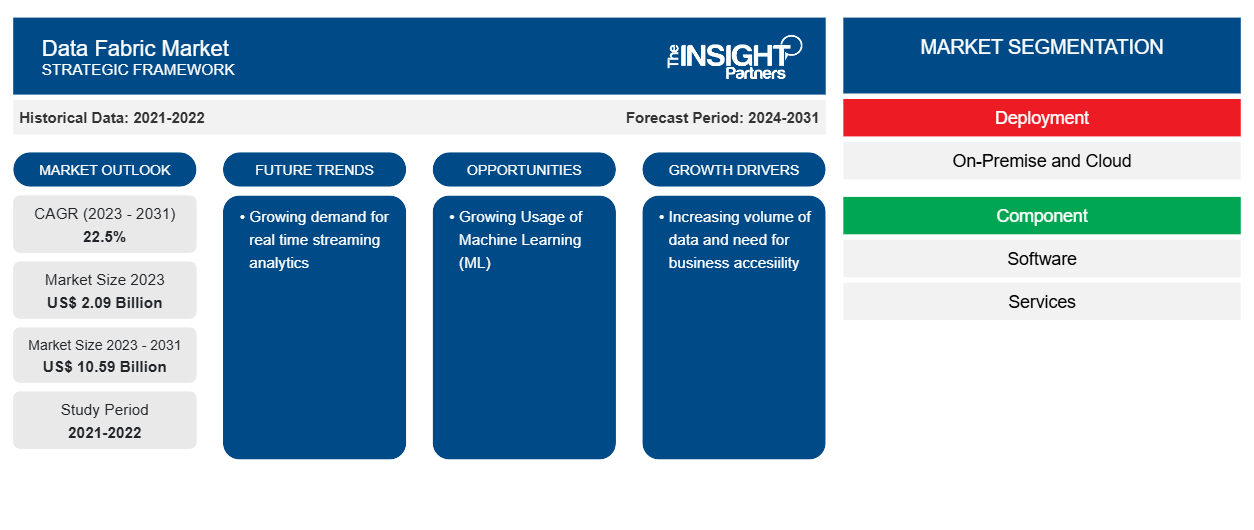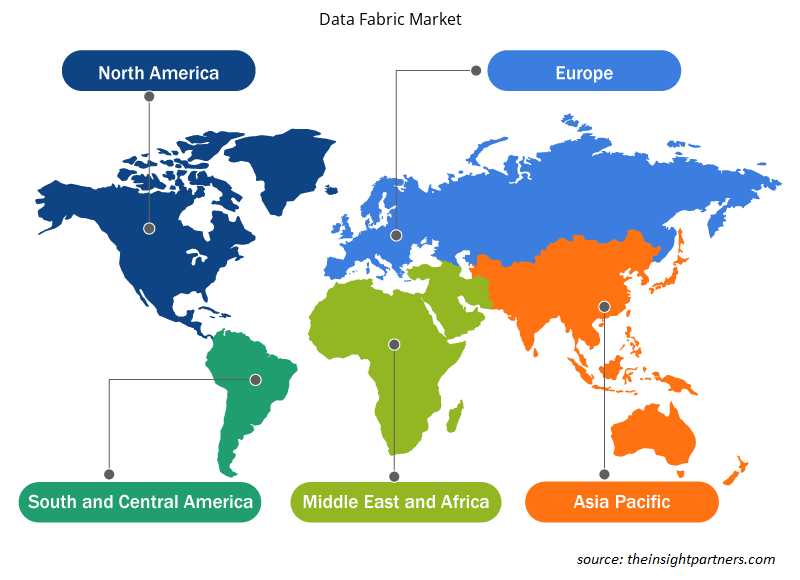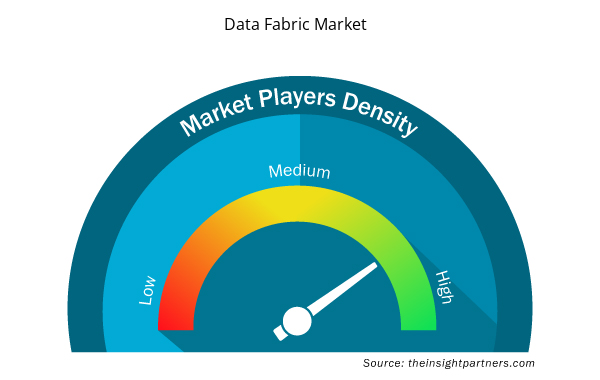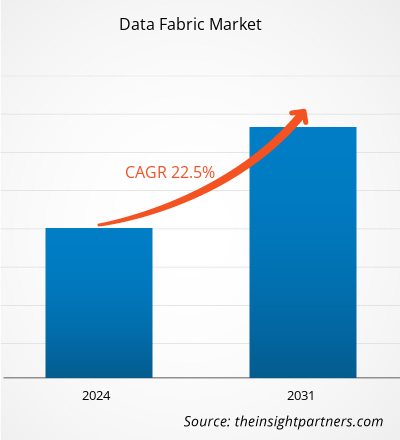The Data Fabric market is projected to grow from US$ 2.09 billion in 2023 to US$ 10.59 billion by 2031; it is expected to expand at a CAGR of 22.5% from 2023 to 2031. Growing demand for real-time streaming analytics is expected to be a key trend in the market.
Data Fabric Market Analysis
The data fabric offers data virtualization, allowing enterprises to implement seamless access to data while making it accessible to everyone. With the implementation of data fabric, business users can access data with minimal IT participation, resulting in a faster and easier environment for data access and exchange. A well-designed logical data fabric centralizes essential security and data management. Thus, the data fabric market is expected to grow during the forecast period.
Data Fabric Market Industry Overview
Data Fabric is a comprehensive data integration and management system that includes architecture, data management and integration tools, and shared data to assist enterprises in managing their data. A data fabric delivers a single, consistent user experience and real-time data access to every member of an organization's global network. Data fabric is intended to assist enterprises in solving complex data problems and use cases by managing data across a variety of applications, platforms, and locations. Data fabric provides frictionless access and data sharing in a dispersed data environment.
Customize This Report To Suit Your Requirement
You will get customization on any report - free of charge - including parts of this report, or country-level analysis, Excel Data pack, as well as avail great offers and discounts for start-ups & universities
Data Fabric Market: Strategic Insights

- Get Top Key Market Trends of this report.This FREE sample will include data analysis, ranging from market trends to estimates and forecasts.
Customize This Report To Suit Your Requirement
You will get customization on any report - free of charge - including parts of this report, or country-level analysis, Excel Data pack, as well as avail great offers and discounts for start-ups & universities
Data Fabric Market: Strategic Insights

- Get Top Key Market Trends of this report.This FREE sample will include data analysis, ranging from market trends to estimates and forecasts.
Data Fabric Market Driver and Opportunities
Increasing Volume of Data to Favor Market Growth
Any data-centric organization requires a comprehensive approach that addresses time, space, various software types, and data locations. Data must be available to those who require it rather than being hidden behind firewalls or scattered across multiple places. Businesses require a safe, efficient, consistent, and future-proof data solution to improve their operational efficiency. Thus, the demand for data fabric is expected to grow during the forecast period.
Growing Usage of Machine Learning (ML)
ML algorithms may monitor data pipelines and suggest relevant linkages and integrations. These algorithms extract information from data as it is linked to the data structure, review all business data, and find relevant linkages and correlations. Providing data is one of the most time-consuming aspects of training an ML model. The Data Fabric design makes ML models more efficient by lowering data preparation time. It also improves the usability of prepared data in various applications and models. Companies distribute data on-premises, in the cloud, and in IoT. The data structure enables restricted access to safe data and enhances ML processes. Thus, the application of ML in data fabric is expected to fuel market growth during the forecast period.
Data Fabric
Market Report Segmentation Analysis
The key segments that contributed to the derivation of the Data Fabric market analysis are coverage by deployment, component, solution, and end user.
- By deployment, the market is divided into on-premise and cloud. The cloud segment led the market in 2023.
- Based on components, the market is divided into software and services
- Based on the solution, the market is divided into data discovery, data ingestion, data orchestration, fabric data access, data management, and fabric management and
- On the basis of end users, the market is divided into BFSI, IT and telecom, retail, healthcare and pharmaceuticals, and others
Data Fabric Market Share Analysis By Geography
Based on region, the market is segmented into North America, Europe, Asia Pacific, Middle East & Africa, and South & Central America.
North American region held a prominent share of the data fabric market in 2023 and is expected to grow at a substantial CAGR during the forecast period. This growth may be attributed to the presence of numerous market platers and early adoption of technological adoption. Further, the Asia Pacific region is expected to grow at the fastest CAGR during the forecast period. This growth may be attributed to the increasing number of data centers and increasing digitization.
Data Fabric Market Regional Insights
Data Fabric Market Regional Insights
The regional trends and factors influencing the Data Fabric Market throughout the forecast period have been thoroughly explained by the analysts at Insight Partners. This section also discusses Data Fabric Market segments and geography across North America, Europe, Asia Pacific, Middle East and Africa, and South and Central America.

- Get the Regional Specific Data for Data Fabric Market
Data Fabric Market Report Scope
| Report Attribute | Details |
|---|---|
| Market size in 2023 | US$ 2.09 Billion |
| Market Size by 2031 | US$ 10.59 Billion |
| Global CAGR (2023 - 2031) | 22.5% |
| Historical Data | 2021-2022 |
| Forecast period | 2024-2031 |
| Segments Covered |
By Deployment
|
| Regions and Countries Covered | North America
|
| Market leaders and key company profiles |
Data Fabric Market Players Density: Understanding Its Impact on Business Dynamics
The Data Fabric Market market is growing rapidly, driven by increasing end-user demand due to factors such as evolving consumer preferences, technological advancements, and greater awareness of the product's benefits. As demand rises, businesses are expanding their offerings, innovating to meet consumer needs, and capitalizing on emerging trends, which further fuels market growth.
Market players density refers to the distribution of firms or companies operating within a particular market or industry. It indicates how many competitors (market players) are present in a given market space relative to its size or total market value.
Major Companies operating in the Data Fabric Market are:
- Denodo Technologies
- IBM Corporation
- Informatica Corporation
- K2View
- NetApp, Inc.
- Oracle Corporation
Disclaimer: The companies listed above are not ranked in any particular order.

- Get the Data Fabric Market top key players overview
Data Fabric Market News and Recent Developments
The Data Fabric market is evaluated by gathering qualitative and quantitative data post primary and secondary research, which includes important corporate publications, association data, and databases. A few of the developments in the Data Fabric Market are listed below:
- LigaData, a leading vendor in the telecom technology landscape, is revolutionizing the telecom data analytics industry with the launch of its new LigaData Telecom Data Fabric 4.0 and LigaData Telecom AI Apps. These new products enable Telcos and Communications Service Providers in their initiatives to transform their businesses from being traditional Telcos into agile data and AI-driven Techcos while driving revenue growth, retaining market share, and enhancing customer experience. (Source: LigaData, Press Release, February 2024)
Data Fabric Market Report Coverage & Deliverables
The Data Fabric market forecast is estimated based on various secondary and primary research findings, such as key company publications, association data, and databases. The market report "Data Fabric Market Size and Forecast (2021–2031)" provides a detailed analysis of the market covering below areas-
- Data Fabric Market size and forecast at global, regional, and country levels for all the key market segments covered under the scope
- Data Fabric Market trends, as well as market dynamics such as drivers, restraints, and key opportunities
- Detailed PEST/Porter’s Five Forces and SWOT analysis
- Data Fabric Market analysis covering key market trends, global and regional framework, major players, regulations, and recent market developments
- Industry landscape and competition analysis covering market concentration, heat map analysis, prominent players, and recent developments in the Data Fabric Market
- Detailed company profiles.
- Historical Analysis (2 Years), Base Year, Forecast (7 Years) with CAGR
- PEST and SWOT Analysis
- Market Size Value / Volume - Global, Regional, Country
- Industry and Competitive Landscape
- Excel Dataset



Report Coverage
Revenue forecast, Company Analysis, Industry landscape, Growth factors, and Trends

Segment Covered
Deployment, Component, Solution and End User

Regional Scope
North America, Europe, Asia Pacific, Middle East & Africa, South & Central America

Country Scope
Argentina, Australia, Brazil, Canada, China, France, Germany, India, Italy, Japan, Mexico, Russian Federation, Saudi Arabia, South Africa, South Korea, United Arab Emirates, United Kingdom, United States
Frequently Asked Questions
The global Data Fabric market was estimated to grow at a CAGR of 22.5% during 2023 - 2031.
Growing demand for real-time streaming analytics is the major trend in the market.
The report can be delivered in PDF/PPT format; we can also share an Excel dataset based on the request.
Denodo Technologies, IBM Corporation, Informatica Corporation, K2View, NetApp, Inc., Oracle Corporation, SAP SE, Software AG, Teradata, and Hewlett Packard Enterprise Development LP (HPE) are the major market players.
Some of the customization options available based on the request are additional 3–5 company profiles and a country-specific analysis of 3–5 countries of your choice. Customizations are to be requested/discussed before making final order confirmation, as our team would review the same and check the feasibility.
The increasing volume of data and the need for business accessibility are the major factors that drive the global Data Fabric market.

 Get Free Sample For
Get Free Sample For